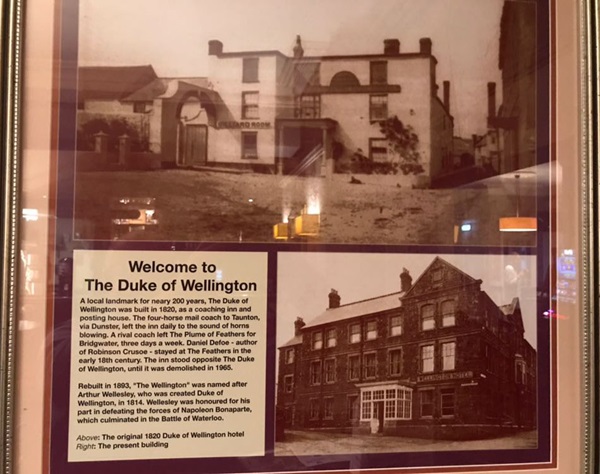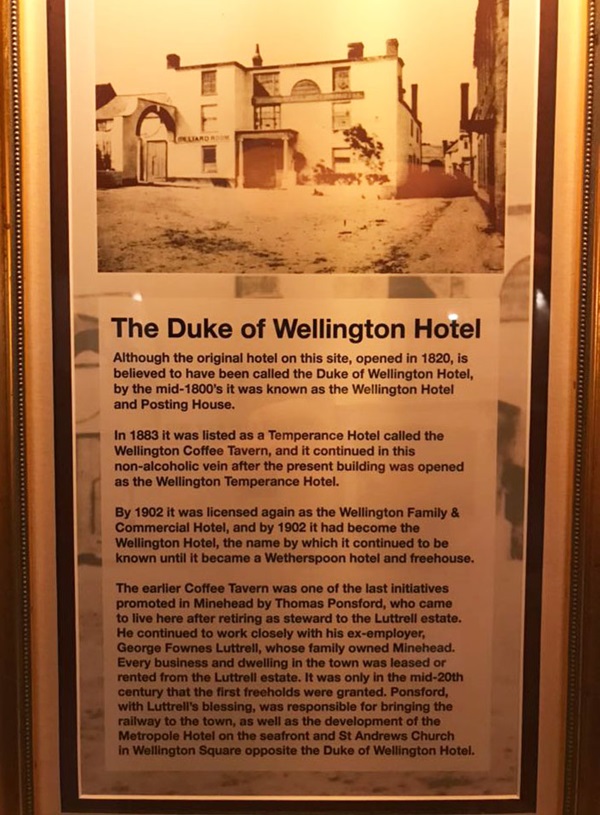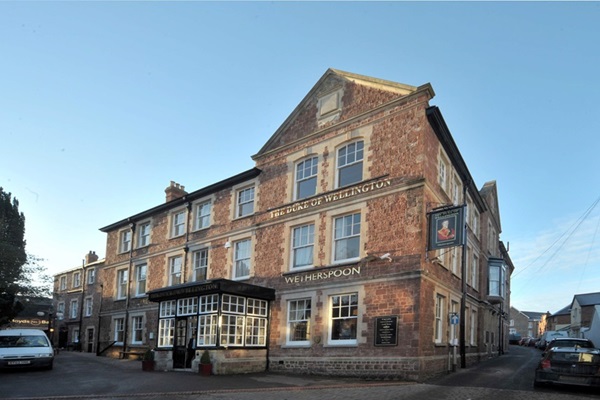This has been a local landmark since 1820. However, for the first 80 years, it was The Duke of Wellington Inn, named after Arthur Wellesley, who was created Duke of Wellington in 1814, for his part in defeating the forces of Napoleon Bonaparte (culminating in the Battle of Waterloo). This was a coaching inn and posting house, rebuilt in 1893. By the early 1900s, it was known simply as the Wellington Hotel, headquarters of the West Somerset Polo Club and convenient for staghound meetings.
Photographs and text about The Duke of Wellington.

The text reads: A local landmark for nearly 200 years, The Duke of Wellington was built in 1820, as a coaching inn and posting house. The four-horse mail coach to Taunton, via Dunster, left the inn daily to the sound of horns blowing. A rival coach left The Plume of Feathers for Bridgwater, three days a week. Danial Defoe – author of Robinson Crusoe – stayed at The Feathers in the early 18th century. The inn stood opposite The Duke of Wellington, until it was demolished in 1965.
Rebuilt in 1893, The Wellington was named after Arthur Wellesley, who was created Duke of Wellington, in 1814. Wellesley was honoured for his part in defeating the forces of Napoleon Bonaparte, which culminated in the Battle of Waterloo.
Above: The original 1820 Duke of Wellington Hotel
Right: The present building.
A photograph and text about The Duke of Wellington Hotel.

The text reads: Although the original hotel on this site, opened in 1820, is believed to have been called The Duke of Wellington Hotel, by the mid 1800s it was known as Wellington Hotel and Posting House.
In 1883 it was listed as a Temperance Hotel called The Wellington Coffee Tavern, and it continued in this non-alcoholic vein after the present building was opened as The Wellington Temperance Hotel.
By 1902 it was licensed again as The Wellington Family & Commercial Hotel, and by 1902 it had become the Wellington Hotel, the name by which it continued to be known until it became a Wetherspoon hotel and freehouse.
The earlier Coffee Tavern was one of the last initiatives promoted in Minehead by Thomas Ponsford, who came to live here after retiring as steward to the Luttrell estate. He continued to work closely with his ex-employer, George Fownes Luttrell, whose family owned Minehead. Every business and dwelling in the town was leased or rented from the Luttrell estate. It was only in the mid 20th century that the first freeholds were granted. Ponsford, with Luttrell’s blessing, was responsible for bringing the railway to the town, as well as the development of The Metropole Hotel on the seafront and St Andrews Church in Wellington Square opposite The Duke of Wellington Hotel.
External photograph of the building – main entrance.

If you have information on the history of this pub, then we’d like you to share it with us. Please e-mail all information to: pubhistories@jdwetherspoon.co.uk